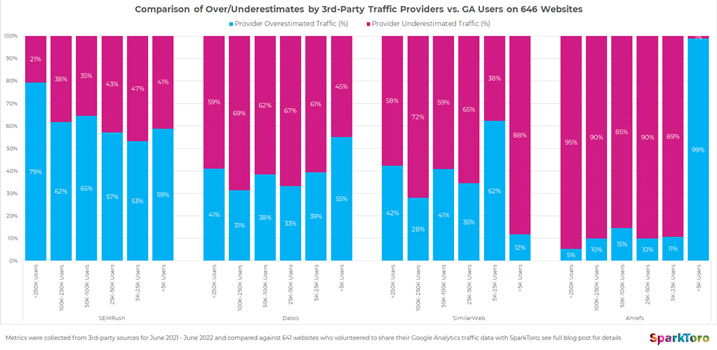

By Simon White, CTO, TheYachtMarket.com
The Dangers of Using Website Statistics Comparison Services Like Similarweb
In today's data-driven world, understanding website performance is crucial for making informed business decisions. Services like Google Analytics and Similarweb offer insights into web traffic, but they do so in fundamentally different ways. Google Analytics provides direct measurements using embedded code, whereas Similarweb offers estimated statistics without direct access to actual site data. This distinction has significant implications for the accuracy of the data these services provide.
Direct Measurement vs. Estimated Statistics
Google Analytics: Direct Measurement
Google Analytics tracks website performance by embedding a small piece of JavaScript code into each page of a website. This code records detailed data about user interactions, including visits (sessions), unique visitors (users), pages per visit, and page views. Because it is based on actual user behaviour recorded in real-time, the statistics from Google Analytics are highly accurate and reliable.
Similarweb: Estimated Statistics
In contrast, Similarweb generates estimates of web traffic based on a variety of indirect methods. These can include analysing data from users who have installed browser extensions, partnerships with internet service providers, and other third-party data sources. While these estimates can provide a broad overview of traffic trends, they lack the precision and reliability of direct measurement tools like Google Analytics.
Comparing Google Analytics and Similarweb Statistics
To illustrate the potential discrepancies between these two approaches, let's examine the statistics for UK traffic to our website, theyachtmarket.com, from April to June 2024. The differences are striking:
- Monthly Visits (Sessions): Similarweb's estimate was off by 30% compared to Google Analytics.
- Monthly Unique Visitors (Users): Similarweb's estimate was off by 36%.
- Pages per Visit (Pages per Session): Similarweb's estimate was off by 63%.
- Page Views: Similarweb's estimate was off by 62%.
These significant variances highlight the potential dangers of relying on estimated statistics for critical business decisions.

SparkToro has carried out a much wider comparison of estimated vs measured statistics, across over 1,000 websites who’s operators shared their measured traffic statistics for the research. You can read their detailed report here which supports our own comparisons.
The Compounding Effect of Inaccuracies
When using estimated statistics for comparisons, these inaccuracies might be additive and magnify the discrepancies. Consider a scenario where two websites each have 1 million visits. If one site's traffic is overestimated by 50% (1.5 million) and the other's underestimated by 50% (0.5 million), the comparative analysis would be 100% incorrect. This level of inaccuracy can lead to profoundly misguided business strategies.
Would you make business decisions based on information that could be wrong by such a significant margin?
The Usefulness and Caution of Estimated Statistics
While services like Similarweb do have their uses, it is essential to approach their data with caution. The primary advantage of such services is their ability to provide a comparative perspective on website performance, which direct measurement tools like Google Analytics cannot offer. However, given the potential for significant discrepancies, these estimates should be used as rough guides rather than definitive metrics.
Similarweb isn’t trying to deceive anyone, in fact, they’re very transparent on this topic as described in this topic on their website. The danger comes when companies use this information without stating that the figures are estimated.
Best Practices
If you encounter sales materials or business reports that include estimated statistics, it's prudent to ask the providing company how these estimates compare to their directly measured statistics. Understanding the margin of error can help you make more informed decisions and mitigate the risks associated with relying on potentially inaccurate data.